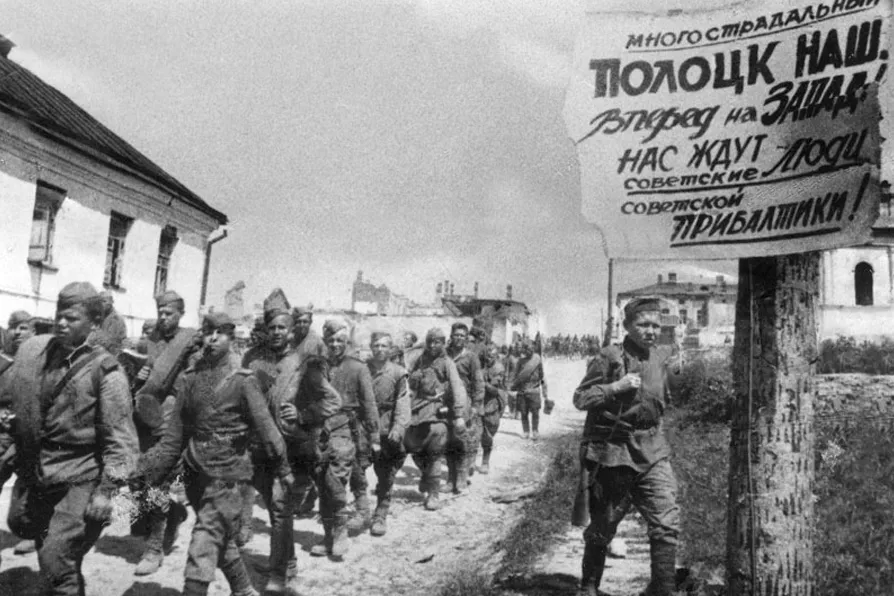MARIA DUARTE reviews Desperate Journey, Blue Moon, Pillion, and Wake Up Dead Man: A Knives Out Mystery
TOMASZ PIERSCIONEK relishes a detailed history of the battles, manoeuvres and tactics that defeated fascism

 SELF-SACRIFICE: Soviet soldiers in Polozk (Belarus), with a propaganda poster celebrating the reconquest of the city and urging the liberation of the Baltic from Nazi German occupation, July 4 1944 [Pic: Public Domain]
SELF-SACRIFICE: Soviet soldiers in Polozk (Belarus), with a propaganda poster celebrating the reconquest of the city and urging the liberation of the Baltic from Nazi German occupation, July 4 1944 [Pic: Public Domain]
Bagration 1944: The Great Soviet Offensive
Prit Buttar, Osprey, £30

RETIRED GP and military historian Prit Buttar launches another foray into the battles of the Eastern Front during World War II. Having published a dozen books about the Eastern Front during the two world wars, Buttar is indisputably an authority on the subject.
His latest book is a weighty description and analysis of one of the biggest offensives during the second world war. Operation Bagration, named after a famed Russian general and nobleman of Georgian origin who fought skilfully against Napoleon’s invasion of Russia in the 19th century, saw the Red Army succeed in pushing the Wehrmacht back hundreds of kilometres over the space of several weeks between June and August 1944. This powerful punch delivered by the USSR, almost three years to the day after the Nazi invasion, culminated in the expulsion of German military forces from Belarus, parts of the Baltics and eastern Poland as the Wehrmacht was steadily ground down and forced back towards the borders of East Prussia.
Buttar’s narrative of events is interwoven with first-hand accounts — diary entries and memoirs — written by soldiers, officers and generals on both sides, as well as battle reports issued by both sides’ headquarters to illustrate the experiences, thoughts and fears of varying ranks during the course of Bagration. Such excerpts provide valuable insights into life on the front line and illustrate the intense fighting and poor conditions faced by fighters, from advancing Red Army troops pushed to their very limits to entire divisions of German soldiers surrounded and cut off from their supply lines.
Buttar excels in providing an almost hour by hour account of the battles, manoeuvres and tactics of both the Red Army and Wehrmacht. In one regard, this book’s strength is also its weakness as it is possible to become bogged down with details and overwhelmed by information as Buttar’s account of Bagration grinds forward narrating battles across the vast expanses of eastern Europe.
Buttar’s work goes far beyond a mere description of events; he provides a critique of both sides’ tactics and leadership decisions to weigh up their successes and failures.
He reveals that the problems which dogged the Red Army in 1941 and saw its forces routed during the opening months of the war — namely, a rigid adherence to outdated military strategies and doctrines as well as poor co-ordination between different branches of the armed forces — were to afflict Germany in 1944 and contributed to its defeat.
The Wehrmacht’s senior officers — sometimes owing their positions to unwavering loyalty to Hitler rather than military skills — frequently followed orders in a slavish manner with few willing to challenge their futility or risk the ire of high command by improvising and making decisions based on the battlefield situation.
More sensible orders often arrived too late to be relevant or were made obsolete by the situation on the ground as the Red Army rapidly advanced, leaving many German divisions surrounded or left defending strategically useless “fortresses” (under strict orders to do so) while cut off from their supply lines.
In contrast, the officers and generals of the Red Army had learnt from their earlier defeats and no longer adhered to rigid doctrines. They had also found ways skilfully to co-ordinate infantry, tanks and artillery forces during an attack. Additionally, the Soviets’ clever use of maskirovka, a concept involving deceiving the enemy into believing the main attack would occur elsewhere, left German armies in the sector where Bagration commenced lacking sufficient forces for defence and counterattack.
Casualties were heavy and by the end of the offensive the death toll reached well into the hundreds of thousands on both sides. Compounded by the launch of D-Day a few weeks before Bagration, Germany found itself squeezed on both sides. Such losses, compounded by strategically unsound decisions from German high command, precipitated a plot to assassinate Hitler centred around Claus von Stauffenberg as German officers felt their best chance of saving what was left of the Third Reich was to replace its leadership and attempt to sue for peace (with Western forces at least). Buttar acknowledges these officers likely had no intention of making peace with the USSR and wished to buy themselves some breathing space. He provides his thoughts on what might have happened if the plot had succeeded.
Buttar also covers the doomed Warsaw Uprising which saw Polish resistance forces stubbornly fight a two-month battle against superior German forces with little or no help from Western and Soviet armies; they were eventually overwhelmed and the fascist invaders committed atrocities against Warsaw’s civilians as punishment.
Buttar’s meticulously researched account will be of particular interests to enthusiasts of second world war history, as well as those wanting to gain a greater insight into the battles, conditions, and tactics on the Eastern Front. Operation Bagration was one of the major turning points in WWII that ensured Nazi Germany’s future defeat would not be in doubt. Its aftermath, such as the Soviet advance across eastern Europe, would determine the future of Europe and set the scene for the coming decades.










